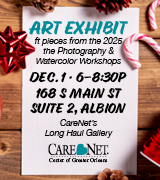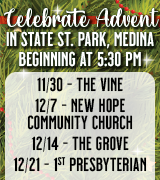‘Canalligator’ can stay; Medina approves 3 murals in historic district
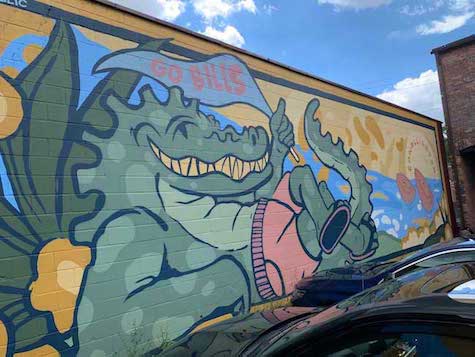
Photos by Tom Rivers: The Canalligator mural on a cinder block building on Proctor Place was approved to stay in the historic district. The Form Foundation, led by Tim Hungerford and his wife Teresa Misiti, is leading the effort to have more modern art publicly displayed in Medina.
MEDINA – The Village Planning Board on Tuesday evening approved three murals in the historic district.
All three are on the back sides of buildings along Proctor Place, a one-way street a block from Main Street.
One of the murals, the Canalligator, was finished last month at 428-436 S. Main Street. Another one with a floral pattern would be on the other side of the same cinder block building as the Canalligator on Proctor Place.
Another project, “Fake It Til You Make It” – will be on the back of 410 Main Street. The mural would go from the floor to the top of the cinder block wall. The mural sends a message of the importance of self-confidence in relation to the pursuit of one’s dreams.
Tim Hungerford and his wife Teresa Misiti are leaders of the non-profit Form Foundation that is spearheading the projects, raising funding, connecting with artists and securing permission from building owners for the projects.
They were faulted for not getting a certificate of appropriateness for the Canalligator mural before it was painted. Hungerford apologized for that. He said he didn’t think the backs of the buildings, with cinder block walls, were considered in the historic district and needed a certificate of appropriateness.
The village was concerned about holding a traditional public hearing with a large crowd in the main meeting room of City Hall. So the Planning Board gave the community the option to email comments about the murals.
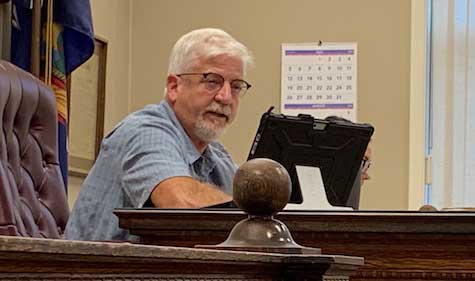
John Dieter, Planning Board chairman, said he consulted with officials from the State Historic Preservation Office who told him murals with modern art are compatible in historic district as long as they aren’t painted on main thoroughfares, aren’t painted on historic stone or prominent architectural features.
The village also received 118 emails about the murals with nearly all in support of the projects. The Form Foundation offered a Canalligator T-shirt for $1 if people showed support for the project. Hungerford said he was copied on 101 emails that were “overwhelmingly positive.”
In a letter from David and Gail Miller, they suggested creating an “art alley” that gives a modern feel to Medina without impacting the traditional beauty of Main Street and the rest of the historic district.
“These projects might be considered a ‘trial run’ to kick off a much larger discussion about the place of art in developing a unique identity of our village,” the Millers wrote in their letter on Aug. 16.
Cindy Robinson, a Main Street business owner and long-time leader of the former Medina Business Association, said the rules weren’t followed in securing a certificate of appropriateness before the Canalligator.
“I’m opposed to the way it was gone about,” she said. “This is about following the regulations like everyone else does.”
The votes to give the murals certificates of appropriateness passed unanimously, 5-0. Planning Board Chairman John Dieter said he consulted with the State Historic Preservation Office. That group said the murals and modern art would be OK in a historic district because they weren’t on a main thoroughfare. Proctor Place is a one-way street.
The murals also aren’t being painted on Medina sandstone or other original historic building materials for the structures. The murals also don’t alter prominent architectural features of the sites.

Chris Goyette, a member of the Medina Planning Board, states his support for bringing art to Medina, including in the historic district. Kathy Blackburn, left, and LaRissa DeGraw also are on the board. “We need to make the regulations more progressive and friendly,” Goyette said.
Dieter spoke after hearing from the other Planning Board members. Earlier in the meeting, Planning Board members Mary Lewis and Kathy Blackburn both said they believed sections of the village zoning ordinance made approval of the projects difficult.
“You have to look at is this compatible with the surrounding properties?” Blackburn said. “That is the law.”
Lewis said she supports public art and she thanked Hungerford and Misiti for working on the initiative. But she felt the wording in regulations said any murals or art should be done to be compatible with the historic district.
Planning Board member LaRissa DeGraw said the regulations doesn’t clearly ban modern art in the historic district. She said there are many examples of modern art and murals in historic districts in other communities.
She said the regulations in the historic district are focused on the front facades of buildings and the historic architectural features – not the backs of buildings and cinder blocks.
“The regulations are vague enough that we don’t have grounds to deny it,” DeGraw said.
She said the Form Foundation has found a way to improve the historic district, by focusing art on the back sides of a few select buildings.
“They are creating a new thing in Medina,” DeGraw said.
She sees the art projects as infusing energy and money into the historic district. That ultimately could give the buildings owners in the historic district more revenue to maintain the properties.
Chris Goyette, another Planning Board member, said the village regulations don’t fully address modern art. That language – or lack – shouldn’t derail the current projects, Goyette said.
“We are a little bit hamstrung but I don’t think it should stop it,” he said about the projects.

The Form Foundation is proposing this mural behind 428-436 Main Street on the opposite wall of the Canalligator. Chris Piontkowski has proposed this design using local, native species of pollinator flowers.
Medina should “become more progressive and think outside the box a little bit,” Goyette said.
He appreciates the effort by the Form Foundation to bring attention to the back of buildings, which Goyette said are often neglected and in some cases, “downright embarrassing.”
“We need to make the regulations more progressive and friendly,” he said.
Hungerford said the three murals, plus another one on a cinder block building at the corner of Pearl Street and West Avenue, all feed off each other. He expects the three new murals will be done by October.
His goal is to have new murals painted over the four sites every two years.
Mayor Mike Sidari said the Village Board will be looking to update the regulations to clearly address modern art. The village may create a Public Arts Commission to help review projects.
Sidari said other artists also are interested in projects in Medina, including under the canal bridges.
He commended the Form Foundation leaders for pushing the projects in Medina.
“Tim and Teresa, thank you for what you’re doing in the village,” Sidari said.
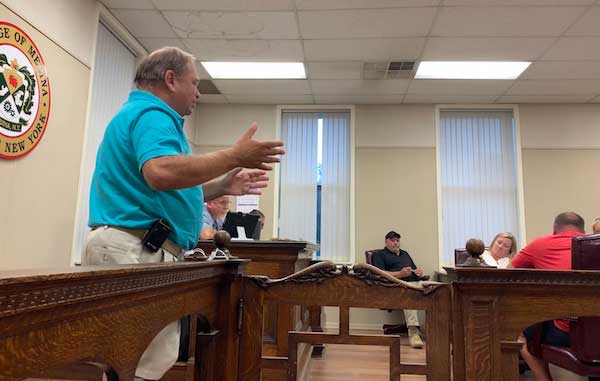
Mayor Mike Sidari thanked the Planning Board for working through a challenging issue. Sidari said the Village Board will be looking to revise regulations and perhaps create a Public Arts Commission to help review and site modern art projects.













